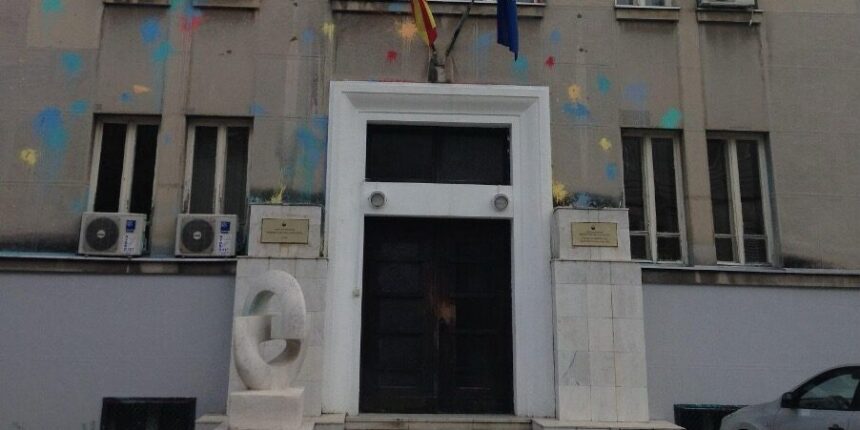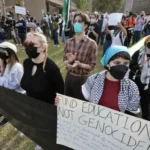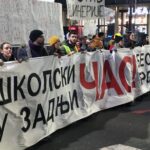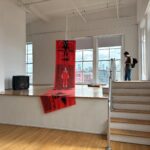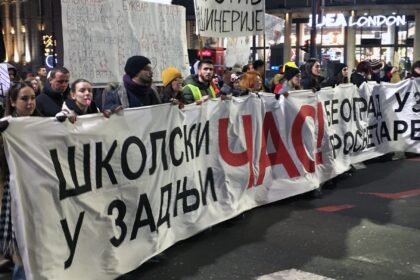Field Report—North Macedonia
Jon Blackwood and Bojan Ivanov
In North Macedonia, the right-wing political party VMRO-DPMNE was returned to power in May 2024, after seven years in opposition. It had been a long seven years; the previous VMRO government of Nikola Gruevski had been forced from power, finally, in the tumultuous period of street protest and militant citizen opposition that had occurred between 2015 and 2017, which became known as Sarena Revolucija– the Color Revolution.
A lively interplay between artist and activist had been at the core of that citizen movement, with a playful visual strategy at the heart of the protest. Dissenting citizens pelted new government buildings and neoclassical monuments, erected as part of the ruinously expensive Skopje 2014 makeover, with rolled up rags dipped in brightly coloured paint. The subsequent pebbledashing of primary colors fulfilled the dual function of ridiculing the pompous new buildings that choked formerly empty space, and the politicians who had erected them.

Vladimir Ilyich Lenin famously said that there are decades where nothing happens, and weeks where decades happen. It feels like there have been several decades since May 2017, when the last VMRO administration was finally ousted, with Gruevski having fled to a well-padded exile in Hungary. Yet early progress under Zoran Zaev’s Social Democrat-led administration atrophied quickly, and weary old forms of corruption and grift began to re-emerge.
This had the effect of not only deeply disappointing citizens who had believed that a change in power might bring about incremental improvements in living standards, but also in demobilizing the possibility of further change. Those involved in Sarena Revolucija were involved in an attritional struggle against a determined and occasionally violent opponent. There is some doubt as to whether that deep exhaustion overlaid by subsequent disillusion and dissatisfaction with organized politics, can be overcome meaningfully in any new struggle.
What of visual art and artists since 2017? The atomising and alienating processes experienced since the coronavirus pandemic has had very profound effects. The country’s fragile visual cultural ecology has not really recovered. Previously, it was possible to chart the emergence of new alloys of ambition and discontent as they emerged from art faculties- the “generational” progression of artists with particular takes of a moment on the relationship between art and society, and the autonomy of art.

Arguably, two of the three participants in the DENES award exhibition of November 2024 are the last identifiable products of an educational “generation”: Ivana Samandova and Jovan Josifovski. Samandova’s intuitive and critically-informed practice deftly negotiates the personal disconnections and the gaps between some of the blustering “radical” rhetoric surrounding contemporary art, and the reality lived daily by contemporary Macedonian artists. Josifovski’s performative installations movingly detail the experience of queer Macedonian lives from history, and the violent discrimination that gay men faced in the country beyond Skopje, in the last century, drawing affinities with practices such as those of Estonia’s Jaanus Saama, if lacking in the conditions for understanding and empathy domestically.
And after these young people—who? In a society where neoliberal property speculation, leading to a financialized credit bubble, and relentless rises in the cost of living against a backdrop of depressed and weak wage levels, it is difficult for these perspectives to cut through, beyond the small educated urban audiences pre-disposed to listen. The problem has moved on from the autonomy of art to the autonomy of the artist; in such a position, apolitical or depoliticized practices are much more welcomed, and artists are carried along with events along with everyone else.
The direction of travel under the new VMRO government is clear enough. Prime Minister Mickovski has been pictured with Trump’s Art of the Deal and the US president’s book is favored reading in government circles. There’s a noted tack towards American right populism and away from Europe which has simultaneously encouraged yet stymied Macedonian ambitions for EU membership since the late 2010s. One of the first administrative moves of the new government was to merge the Ministry of Culture with the Ministry of Tourism, under the charge of former actor and theatre director Zoran Ljutkov. The direction of travel in the years ahead will be ever declining budgets for culture, and a subordination of culture to the economic interests of the tourist market—meaning a focus on ancient ruins, national identity and archaeology, rather than any support for critical contemporary practices.
In this direction the government have been encouraged by Trump’s assumption of power and cancelling of US Aid programs, which savagely affected the budgets of Skopje Pride and the feminist festival Prvo Pa Zensko. These important organizations were the only two that did not receive any funds from the Ministry of Culture and Tourism in the annual competition for funds, leaving their very existence in doubt. It is clear that the battles the government will pick will be in the culture wars, rather than explicitly visual culture.
On March 16, 2025, a devastating fire destroyed the Pulse nightclub in Kochani, a town one hundred kilometers east of Skopje. 62 young people lost their lives and 193 were injured. In the aftermath of this appalling tragedy and loss of life, corruption once again became central to political debate, with citizens taking to the streets of Skopje and towns across Macedonia, protesting at the corruptly awarded permits and non-existent fire safety protections that were the main factors in the tragedy.
For a brief moment it appeared that the anger in the wake of Kochani may destabilize Mickovski’s government and indeed the political class and the judiciary. However, right wing authoritarians care not so much for legitimacy, but for the exercise of power in their own interests. They know how to wait out moments of public anger and trust in their dissipation through exhaustion. At present it is difficult to tell where the long and difficult process of prosecuting the dozens of government officials arrested in the wake of the Kochani fire will lead. It is still less easy to predict what, if any role, Macedonia’s small community of artists might have to play in these complex ongoing processes.
Dealing with right wing authoritarianism and corruption is not a new thing in Macedonia but has been a weary reality for citizens for over twenty years. Public mobilization over a common plight may, at times, result in a popular organization involved in a political struggle. Even though dignified non-violent protests in Kochani and the establishment of decision-making citizen’s plenums have begun, quick results—not to say welcome results—shouldn’t be expected anytime soon.
Jon Blackwood is an Associate Professor in Contemporary Art at Gray’s School of Art, Robert Gordon University, Aberdeen, Scotland. He is active as a curator and writer and has been working for twenty years in the former Yugoslav space, focusing on cultural ecologies and intersections between the practices of contemporary art and radical politics. He spends his time between Aberdeen and Skopje.
Bojan Ivanov is an art historian and art critic whose work is divided between the preservation of cultural heritage and assessments of the contemporary cultural moment. He recently retired as founder and program manager of Mala Galerija in Skopje [Little Gallery].

